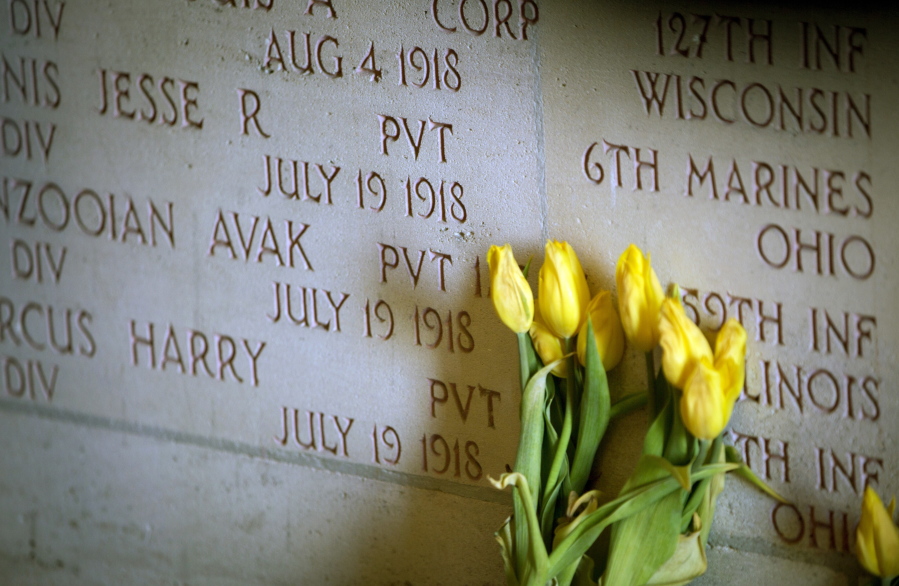BELLEAU, France — It was the spring of 1918, and the German army was making a final push toward Paris. The only thing in their way was a contingent of Allied troops, including untested U.S. forces near the Marne River in northern France.
Among them: U.S. Army 1st Lt. Gordon Kaemmerling, a precocious and athletic Harvard graduate who had jumped at the opportunity to help the United States leave its shell of isolationism and join the war.
On June 6, 1918, the U.S. forces attacked, storming across the open fields near Belleau Wood. Germans sprayed them with shells and machine-gun fire from a densely forested hill. Without proper artillery cover, the Americans were mowed down easily at first.
In the chaos, the 26-year-old Kaemmerling rushed to help his comrades, and was nearly torn in two by shrapnel and bullets.
The bravery of Kaemmerling and others helped the Americans chase the German forces out of Belleau Wood by the end of the month. The battle became a defining moment in World War I, not just containing the German push along the Western Front but proving the Americans’ military mettle for all to see.
Victory bonded the Allies, and that friendship became the cornerstone of global diplomacy for most of the last 100 years.
That partnership is being celebrated during the centennial of the battle of Belleau Wood as the U.S. marks the Memorial Day holiday, even amid some trans-Atlantic strains.
No retreat
Germany acknowledged the arrival of the U.S. forces on the Western Front would be a burden, but peace with the Bolsheviks in Soviet Russia meant that German troops could reinforce another onslaught on France.
It was a unique window of opportunity for the Germans, and when it came, they got within a week’s march from Paris. Victory after four years of fighting seemed possible.
The American force “was still considered a very untried organization, and among the French and British, they were not sure how well they would perform,” said retired U.S. Army Col. David S. Jones, a historian.
The initial plan was to give many of the U.S. forces more time to train before being thrown into battle, but Germany had other ideas.
In desperation, the French asked U.S. Gen. John J. “Black Jack” Pershing for the immediate deployment of his some of his troops to stop the gap near the Marne, northeast of Paris. U.S. soldiers and Marines were soon sent off to Belleau.
The combination of inexperience and gung-ho enthusiasm became the stuff of legend. The battle is one of the first things taught to any U.S. Marine, said Owen Gardner Finnegan, a Marine who served in Afghanistan and was visiting the Belleau Wood cemetery.
Because of their ferocity, the Americans “stopped the most advanced army in the world at the time in savage fighting,” Finnegan said.
Marine Corps lore has it that one officer, told there was a general retreat, said, “Retreat? Hell, we just got here!”
The Americans made their vigor, youth and resilience count against the more experienced but battle-weary Germans, who were approaching their fifth year of fighting.
When the Americans were confronted with “intense enemy fire, instead of ducking, instead of retreating, they charged,” said French historian Jean-Michel Steg.
At first, it was a matter of survival. Steadily, however, they established themselves in hostile terrain where any tree could hide an enemy. They stood their ground in man-to-man fighting.
Instead of marching on Paris, the Germans soon found themselves on the back foot.
Much more was at stake than a patch of ground along a 350-mile front line.
“It became something different. It became a test of will,” Steg said.
Bolstered by the Americans, the Allies were pushing the Germans back.
“The turning point was that the Germans came to the realization that the American Army was for real and was not only going to get bigger with the arrival of new soldiers each month but was also going to get better,” Steg said.
By the end of 1918, more than 2 million Americans were on the front.
Belleau Wood “definitely was a critical point in the road for America becoming a world power,” Jones said.
Other successes by U.S., French and British Commonwealth forces led to the armistice of Nov. 11, 1918.
The U.S. would return again to Europe to fight and defeat the Germans in World War II.



